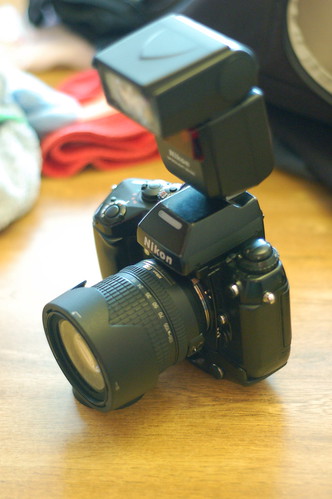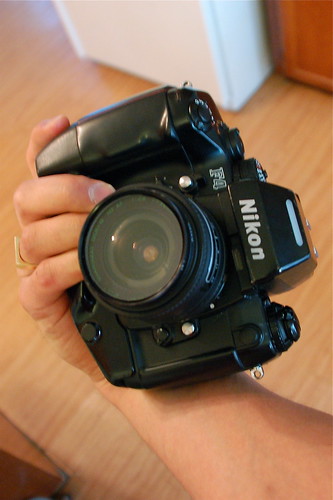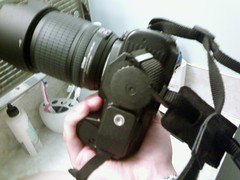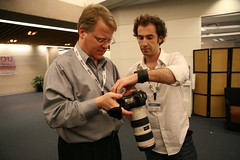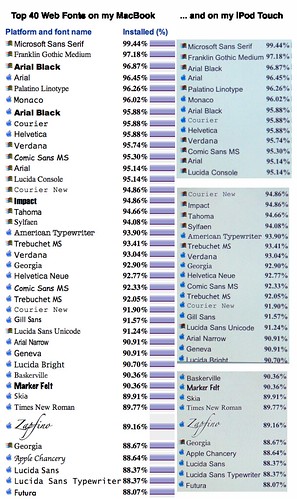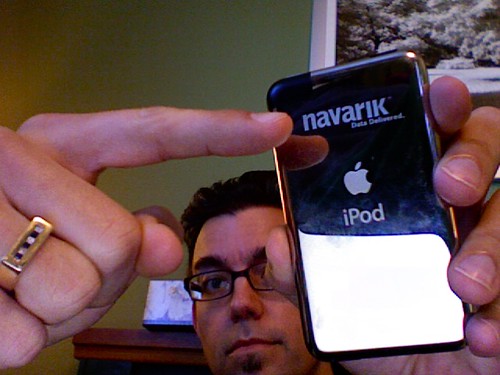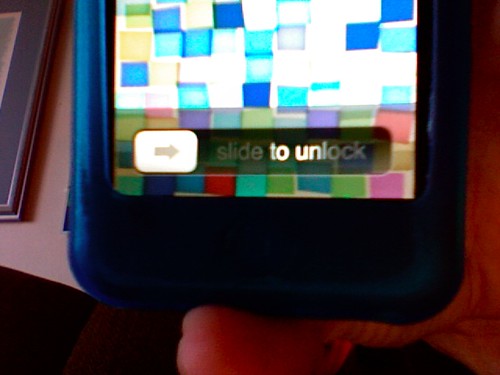Penmachine
02 March 2010
Chirp
Last week, around 3 a.m., there it was.
Chirp.
Somewhere in the house. Was it electronic, or alive? Probably electronic, but it didn't sound like any of our cordless or mobile phones when their batteries die. Then again, a few seconds later.
Chirp.
I got out of bed and stood in the hall, in the dark.
Chirp.
It seemed everywhere and nowhere. Was it upstairs or down? Living room? Kitchen? Bathroom? Downstairs office? In the walls?!
I waited.
Nothing. It had stopped before I could isolate it. Was it a battery not quite depleted enough? Or something that heard me? No way to know, so I went back to bed.
In the morning I saw that our new PVR was full, deleting the oldest recorded programs to make room for new ones. Perhaps it had chirped a warning? I purged some archives, leaving lots of room. Taken care of, perhaps.
I'm not sure if it was the next night, or maybe two later. 5 a.m.
Chirp.
I was up immediately, head cocked to the side. Where was it? What was it?
Chirp.
Maybe it was a phone after all, left out on a table or sucked inside the couch cushions. Or some other device we have that I'd forgotten about, an old Tamagotchi or McDonald's Happy Meal promotional toy, perhaps?
Silence again. Nothing. Back to bed, until the next night, only 1:30 a.m. this time.
Chirp.
Wait, it was quieter in the kitchen and bathroom. More to the front of the house.
Chirp.
Downstairs! I crept down our creaky steps, not wanting to wake everyone else.
Chirp.
In the carport? That didn't make sense.
Chirp.
Nope. Laundry room.
Chirp.
And I was staring at it, right over my head. The basement smoke detector, whose 9-volt battery was weakest late at night, when the house is coldest and electron-moving chemical reactions slowest. I pulled it down, removed the battery, and stomped back to sleep.
We had peace at night now. Until a couple of nights later, 2 a.m.
Chirp.
What the hell?
I immediately went downstairs. No, it wasn't the laundry room smoke alarm. That still lay on the dryer, dead battery beside it. Pushing its test button did nothing.
Chirp.
My younger daughter L's room. I'd forgotten that we'd bought two smoke detectors, of the same brand, with the same batteries in them, on the same day when we renovated her bedroom so she could move downstairs.
Chirp.
I wanted to rip it off the wall, but L was asleep right there, so I gingerly rotated it out of its mount, took it to the laundry room, tore out the battery, and left it in a heap beside its twin. In the morning she asked me why it was missing from the wall, and I explained.
Both alarms have new batteries now, and next time I hear that chirp, I'll know exactly where it's coming from.
Labels: family, fire, gadgets, home, sleep
08 February 2010
Choosing disposable books
For Christmas, my longtime friend Sebastien bought me an Amazon Kindle ebook reader. It's been great—while it has its flaws, it's a convenient and non-fatiguing way to read electronic documents, much more pleasant than the backlit screens of my laptop or iPhone (or, probably, the iPad). But I find it has also influenced my reading choices in an interesting way.
I first read a few ebooks that I had kicking around on my hard drive, mostly in plain-text format. I honestly don't remember where I got them, since I've had them so long. They're almost all science fiction titles, and judging by the oddball typos, most of them were obviously illegitimately scanned and OCRed years ago. But the Kindle does a good job with plain text, so I was impressed.
Next, I moved on to buying a few books at Amazon's Kindle Store. And it's the store that altered my choices. So far I've only bought three ebooks there, but the ones I've sampled without buying have been similar, and uncharacteristic for me.
Kindle books, like most ebooks these days, are locked down by DRM, making then significantly less portable and shareable than plain-text or other open formats, or than traditional paper books, and more likely to suffer digital rot, likely making them inaccessible years down the line. So the ebooks I have bought and read aren't the type I would previously have kept on my bookshelf. All of them, oddly enough, have been memoirs, not a genre I've previously chosen much:
- Infidel by Ayaan Hirsi Ali
- Tokyo Vice by Jake Adelstein
- American on Purpose by Craig Ferguson
I recommend all three, by the way, though Infidel is the best if you choose just one. But I consider memoirs generally disposable: I can read them once and not have much interest in re-reading them in the future. Maybe that's why my mom has always been a reader of memoirs and biographies. For decades, she has picked them up second-hand and breezed through them in a few days.
My gut feeling is that DRM-protected ebooks should cost less than they do: $5 to $7 feels about right, while the current $11 to $15 range for many mainstream titles (like the three I read) is too much—though I might regularly pay the higher price for unlocked ebooks. I don't think I'm alone in this: notice that many of Amazon's Kindle bestsellers are in the cheaper price range. Also notice that many of those books are old enough to be public domain, so no one has to pay the authors anymore. You can even get them for free, and unlocked, elsewhere.
Ebook prices can be more flexible than traditional hard-copy paper book prices, though. Publishers seem to want to charge $15 and up for in-demand new titles, and then lower prices to pick up more price-sensitive readers later—and they seem willing to fight to be able to do that. I'm willing to wait, so I guess that sort of arrangement would be okay with me.
I'd still prefer they ditched the DRM. And I'd still pay a bit more for that if they did.
Labels: amazon, books, drm, ebooks, gadgets, money
28 January 2010
Living in the future
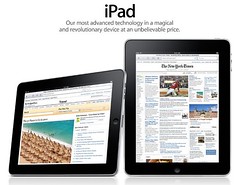 Not having seen or touched Apple's new iPad myself, I can't contribute much new to the vast conversation that has been swirling around this device over the past day. But I can say two things:
Not having seen or touched Apple's new iPad myself, I can't contribute much new to the vast conversation that has been swirling around this device over the past day. But I can say two things:
- Until yesterday I would have planned to replace my current MacBook with another laptop when it wears out. I’d now consider getting an iMac (or even maybe a Mac Mini) as a primary computer, and using an iPad as a living room/kitchen/bedtime/on the road companion device. In the roughly-$2000 price range you could get a 15-inch MacBook Pro, or a 21-inch iMac, plus an iPad. I can see a lot of power users and tech heads going that route.
- We'll get used to it, but iPad is a dumb name. On a lark, I started a Facebook group suggesting that we call it the Slabapple, which is also a dumb name I made up, but which I think is less dumb than iPad. Feel free to join us, for whatever that's worth.
The key thing, I think, is that this is the first version of the device. My guess is that it will have legs, and that—as happened with the iPhone—whatever iPad is available in two or three years will have everyone forgetting the many complaints about today's version.
P.S. Oh, and this (via Jeff Croft).
Labels: apple, controversy, gadgets, geekery, imac, ipad, macbook
28 November 2008
Practical extravagance
 If money were no object, I wouldn't be one to buy a fancy car or a mansion—I'd get something good in each case, but also something practical. It's the same with cameras.
If money were no object, I wouldn't be one to buy a fancy car or a mansion—I'd get something good in each case, but also something practical. It's the same with cameras.
I've used Nikon's top-end D3, and it's a fine instrument, but far more camera than I'd need. The D3x, just mistakenly announced today, would be even further overkill. Never mind the various medium format cameras and the upcoming ultra-luxe Leica S2.
So, if I were suddenly independently wealthy, I'd still get myself a new Nikon, but it would be the D700, which packs most of the power of the D3, including its wonderful low-noise, high-sensitivity full-frame sensor, into a smaller (we're talking relatively smaller here) package. I've also tried the similarly sized D300, so I think the D700 would fit better in my hand.
And I'd buy some great lenses too, of course, because that's where money is best worth spending. I'm still using an inexpensive but quality lens I bought in 1995, while the camera it went with is long, long gone.
Finally, I'd travel to beautiful places with my family, to make photos with them.
Labels: gadgets, money, nikon, photography, travel
17 October 2008
Links of interest (2008-10-17):
Sorry, I'm not keeping very good track of my sources for these:
- Eighty-four variations of the iconic Obama "HOPE" poster.
- "...incentive plans based on measuring performance always backfire. Not sometimes. Always."
- "If I have grown more cynical in recent years, it is travel, I think, that has pushed me in this direction. Exploring other parts of the world is beneficial in all the ways it is typically given credit for [...] But traveling can also burn you out, suck away your faith in humanity. You will see, right there in front of you, how the world is falling to pieces."
- A $15 USB controller shaped like the classic Atari 2600 joystick.
- Fabulous video of the recent SpaceX launch—the first successful commercial orbital rocket launch ever. If you're interested, here's a Google Maps satellite photo of the launch facility in the South Pacific, midway between Hawaii and New Guinea.
- Why we can't imagine what it's like to be dead.
- Blues guitar legend Robert Johnson died 70 years ago. Someone might have recently discovered a new photograph of him, one of at most a handful existing.
Labels: death, gadgets, linksofinterest, money, music, photography, politics, space, travel
02 September 2008
It is a new world
Included on my ten-year-old daughter's school supply list for this year:
1 USB flash memory key
The smallest and cheapest one we could find was part of a stack of them on a school supply table at Staples. 1 GB for $20, and smaller than an eraser. I think I hear the echoes of my young geeky self swooning in disbelief.
Labels: family, gadgets, geekery, memories, school
09 July 2008
The monster film camera arrives
 Yesterday I got an online notice that my eBay purchase Nikon F4 film camera had cleared Canada Customs. I thought that might mean it would take a few more days to arrive, but the Canada Post truck showed up with it this afternoon. I made some camera nerd unboxing photos with my digital SLR if you'd like to see them.
Yesterday I got an online notice that my eBay purchase Nikon F4 film camera had cleared Canada Customs. I thought that might mean it would take a few more days to arrive, but the Canada Post truck showed up with it this afternoon. I made some camera nerd unboxing photos with my digital SLR if you'd like to see them.
I have to say this: wow. For a 20-year-old design, the F4 is an amazing camera. It weighs a ton, because it's both huge (freakin' huge) and made of thick metal under the rubber covering, but it feels great in my hands. It's remarkably responsive, easy to figure out for anyone who grew up with the dials, knobs, and buttons of an analog SLR, and fast.
I'd also forgotten what it's like to look into a bright, full-frame, 100%-coverage viewfinder with minimal clutter. Compared to the finder view in my D50, it's expansive, and having only one central autofocus point plus a couple of etched circles (to show where the different types of light metering act) means there's a lot less other stuff busying up the view.
All my Nikon-mount lenses fit and work—even ones with technology designed more than a decade after the camera ceased production—although the newest, designed for a smaller digital sensor and lacking an aperture ring, is limited and vignettes heavily. Most surprising, my SB-600 flash functions pretty much fully, including reading lens focal length, working with through-the-lens (TTL) metering, and acting as an autofocus illuminator (which the camera otherwise lacks).
Running the motor drive at top speed yields a full paparazzi kssht-kssht-kssht-kssht-kssht, much faster than my lower-end D50 digital SLR from 2006. Autofocus is surprisingly quick too, though not up to complete modern standards. Unlike my D50, the F4 has mirror lockup, dedicated buttons for exposure and focus lock, depth of field preview, and an eyepiece shutter on a removable viewfinder pentaprism.
I loaded the F4 up with some Ilford black-and-white film and took it along while my younger daughter and I walked to the store and the park this sunny afternoon. I also picked up a new camera strap at Kerrisdale Cameras, since none of my current ones have the keychain-style metal rings at the ends that work with the F4's teeny tiny metal strap connectors. And I'll have to track down a rubber eyepiece ring, since that's the only stock item missing from the camera.
Of course, the key frustration with any film camera is that you can't see your pictures right away—I'll have to wait to finish the roll and get it processed, just like I did my entire picture-taking life from childhood until I bought my first digital camera in 2002. And yet that also forces me to think a bit more: How will this look in black and white (for this roll)? What's the best angle for this shot (I can't waste film trying a bunch of different ones)? What works in this light at this film ISO setting (since I can't adjust that)? What kind of depth of field and shutter speed do I want? And so on.
Perhaps the greatest pleasure comes from something I haven't had in more than 15 years: an SLR camera with analog controls for every feature, not multifunction digital buttons and mode dials and four-way controllers and LCD screens. Other than the lack of a manual film winding lever, and the info LCD inside the viewfinder, the F4 has the same kind of excellent tactile controls and analog displays photographers relied on for decades, from the first Leica rangefinder shooters to the astronauts walking on the moon.
There's definitely a difference adjusting the lens opening with an aperture ring on the lens, and the shutter speed with a dedicated dial on the top of the camera, than with the one or two thumbwheels on the handgrips of modern digital (and even film) SLRs. In the digital era, only the otherwise imperfect Panasonic Lumix DMC-L1 and Leica M8, with their retro aesthetic, offer anything like that.
Obviously, I don't have any of my photos from the F4 yet. But I'll link them up when I do.
Labels: film, gadgets, geekery, leica, moon, nikon, photography
04 July 2008
Matchstick and Microsoft are sending me a free Zune to review
 I was a bit surprised to be contacted by Matchstick, a Canadian "word of mouth marketing" company, yesterday. I figured after some of their missteps a couple of years ago, they might have gone out of business—but instead it seems like they might have learned a thing or two and survived.
I was a bit surprised to be contacted by Matchstick, a Canadian "word of mouth marketing" company, yesterday. I figured after some of their missteps a couple of years ago, they might have gone out of business—but instead it seems like they might have learned a thing or two and survived.
They've been contracted by Microsoft to find bloggers and other types like me to evaluate the Zune media player, software, and online marketplace, which has finally become available in Canada after its U.S. release almost two years ago. I (and Chris Pirillo) had a chance to play with the first-generation Zune—yes, the brown one—briefly in Seattle before that original release, and I was impressed with the hardware and user interface. At a recent trip to Best Buy, I also liked the fun but very un-iPod-like approach to the Zune onscreen user experience, despite the extremely iPod-like form factor of the device itself.
But I haven't had a chance to work with the Zune software at all, and reviews of that over time have been mixed. Matchstick will be sending me a black Zune 8 to try out, so I'll find out for myself. But I'll either have to borrow a Windows PC from someone, or install Windows on my MacBook, to get it to work—there's no Mac support, alas.
But with luck I'll be able to find out whether our Zune subscription links at Inside Home Recording actually work. The little Zune should arrive next week sometime. Maybe I can photograph it with the new/old camera.
Labels: audio, gadgets, ipod, microsoft, zune
03 July 2008
State of the digital SLR market: Nikon, Canon, Sony, Olympus, Panasonic, Pentax, and Leica
Last year I created a little composite image of the various interchangeable-lens digital single-lens reflex (DSLR) cameras then available from Nikon and Canon, the two leading camera manufacturers. It turned out to be one of my most popular pictures at the Flickr photo sharing service, of course because photo enthusiasts like to argue about Canon vs. Nikon almost as much as Mac and PC people do about their computers.
It became out of date pretty fast, with models discontinued and new ones introduced. But people kept looking at the image and commenting. So I decided to go further and create a similar composite visual chart of DSLRs currently available, as of the end of June 2008, from all the major camera makers: Nikon, Canon, Sony/Minolta, Olympus, Panasonic/Leica, and Pentax. The pictures are all the companies' publicity photos, sometimes sourced directly from their websites, sometimes from others such as DP Review and DC Resource:
No wonder people are confused about which camera to buy! Prices here range from around $500 (with lens) to about $8000 (no lens). The smallest cameras in this bunch are the Leica M8 (off by itself on the lower right, and not an SLR, see below) and the Olympus E-420 (top of the fourth column, see this review for real-life size comparison photos). The heaviest are the two pro monsters, the Nikon D3 and Canon 1Ds Mark III, in the lower left.
I have excluded a few other makers, such as Fuji and Sigma, and rebadged models from Samsung (nearly the same as some Pentaxes) and Leica (almost identical to the Panasonics). These images reflect the main line of SLRs (plus the M8) as of this writing.
Relative camera sizes are not exact. The positions of the various models vaguely reflect my impressions of a combination of price, features, and market segment. That's quite subjective, so you could easily argue with my placement of some of them. Take the image as a general guideline. Look down the columns to see how different cameras from a single manufacturer compare from low-end to high-end; look across the rows to see roughly comparable cameras (in features, price, or both) from different makers that compete with one another.
Nikon and Canon are (currently) alone in providing full-frame size semi-pro and professional DSLRs: the D700, EOS 5D, D3, and EOS 1Ds Mark III. The Leica M8 is the real outlier—not an SLR at all, but a digital version of the classic Leica M rangefinder; I put it here because a significant number of photographers looking at the high-end Nikons and Canons might also consider it.
The most crowded market segments are the introductory level (with something, and sometimes several confusing models, from every manufacturer), and the midrange enthusiast section (with some interesting choices like the D80, D300, 40D, A700, E-3, DMC-L1, and K20D). With all the choices, this might be the most interesting time in the history of single-lens reflex cameras, certainly in the digital era.
I also left out some models. Canon's pro sports-focused 1D Mark III, which looks and works essentially identically to the 1Ds Mark III, is one—the difference is that the "s" indicates a larger full-frame sensor (Canon needs a serious simplification of its naming scheme). The Nikon D40 is also the same body as the D40x (and the D60), but with a lower-resolution sensor. Some of these models, such as the D40x and the Canon XTi, may be theoretically discontinued now or soon, but remain widely available.
Finally, there will probably soon be updates rendering this composite chart at least partially obsolete. Canon is expected to replace the three-year-old EOS 5D any old time, Nikon might do the same for the similarly aged D80, Sony may release a full-frame DSLR (since they make Nikon's full-frame sensor, I believe), and Nikon could bring out a D3x or similar model with a higher-resolution full-frame sensor like the 1Ds Mark III. I'll let you know.
Labels: canon, gadgets, geekery, leica, nikon, olympus, panasonic, pentax, photography, sony
02 July 2008
Goin' back to Cali... I mean film
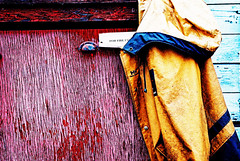 I've been writing more about photography lately, largely because I've been doing more of it, especially weird stuff like high dynamic range pictures—it's a hobby I can play with even when I'm on chemotherapy or otherwise ill. I've been happy using my Nikon digital SLR and small lens collection.
I've been writing more about photography lately, largely because I've been doing more of it, especially weird stuff like high dynamic range pictures—it's a hobby I can play with even when I'm on chemotherapy or otherwise ill. I've been happy using my Nikon digital SLR and small lens collection.
This week, Nikon introduced a new high-end DSLR, the D700. Of course it was fun to read about, but my D50 is just fine; the D700 is far beyond anything I need to use, and at $3000 is well out of any price league I'm likely to be in for a long time.
One thing I have been wanting to try is cross processing, of which I've seen some great examples in Kris Krug's photostream at Flickr. Cross processing, however, requires a film (not digital) camera. It usually involves taking slide film and instructing your film lab to process it using the same chemicals used for print film. Like HDR, cross processing creates some bizarre, surreal effects, as in these pictures from Kris. Taking some black-and-white shots might be fun too.
However, my last film SLR, a Nikon F601, died several years ago (the film transport crapped out while we were taking family Christmas pictures). I still use a couple of the lenses I bought for it on my digital D50, but I currently have no way to take film photos. Fortunately, now that we're well into the 21st century and the digital era, used film cameras are ridiculously cheap. As long as you're not going for a Leica or a Nikon F6, it's actually difficult to spend more than a couple of hundred bucks on even a very nice older film body.
So yesterday, Canada Day, I hunted around on eBay a bit and found this:
It is a used, slightly but deliciously worn Nikon F4s, which was Nikon's revolutionary top-of-the-line professional camera from 1988 to 1996, when it was replaced by the F5. The photographer at my wedding in 1995 (likely the year the particular one above was made) used the F4, as did many photojournalists, sport photographers, and other professionals a couple of decades ago. I put in a bid for the F4s above, and I won.
I've tried out a used F4 in a local camera store before, and unless you've handled a top-shelf professional DSLR—film or digital—the heft of the thing is a little hard to describe. Like the current flagship Nikon D3 or Canon 1D, it is large, extremely solid, heavy, and yet still very nice to hold. While it is a fully electronic, autofocus and autoexposure camera, all the controls on the F4 are analog: dials, buttons, and levers. There is no external LCD panel or menu system. It feels like you could hammer nails or fend off a robber with it and keep taking pictures afterwards.
Although it was designed when I was in my early years at university, there are numerous ways the F4 outperforms any camera I've ever owned, including its fast and precise continuous shooting frame rate (5.7 frames per second, almost twice as fast as my D50), and at least basic compatibility with (as far as I can tell) every F-mount SLR lens Nikon has ever made—from the earliest manual-focus models from 1959 to the latest autofocus ones from 2008—including all the ones I own. The F4 is midway through the line of professional Nikon F cameras made over the past 50 years:
All this for just over $200. That's about the price of a nice pair of boots, a decent set of men's clothes, an 8 GB iPod nano, or a low-end zoom lens today; $100 cheaper than Nikon's current low-budget student manual SLR, the FM10; about a third as much as the current intro-level Nikon or Canon digital SLRs (or what I paid for the D50 in 2006); and a mere 10% of the $2000 cost of a new F6—or of the F4 itself at introduction in September 1988.
My new/old F4 should arrive in a week or two. Now the question is: where do I buy slide or B&W film in Vancouver these days?
Labels: film, gadgets, geekery, leica, nikon, photography
18 June 2008
Buying your first serious digital SLR camera
 I get emails out of the blue sometimes, and yesterday a guy who found me via Flickr asked my advice on buying his first serious digital SLR (single-lens reflex) camera. He's already quite a good photographer, with a keen eye, and he's trying to decide between the Nikon D300 and Canon EOS 40D.
I get emails out of the blue sometimes, and yesterday a guy who found me via Flickr asked my advice on buying his first serious digital SLR (single-lens reflex) camera. He's already quite a good photographer, with a keen eye, and he's trying to decide between the Nikon D300 and Canon EOS 40D.
He likes the Canon's interface, but prefers the features of the D300, as well as the more vivid colours it produces (at least in JPEG mode). He wants low noise, good low-light performance, and good ability to take landscapes, high dynamic range (HDR) photos, and macro (closeup) pictures.
When you're starting out buying an SLR, what you're doing is committing yourself to a camera system, particularly with lenses. Chances are you will keep and use the lenses for much longer than you use that camera. For instance, I have a Nikon D50 I bought in 2006, but my lenses include a zoom that I bought in 1995 for my old film Nikon, and which still works great. I've been using Nikon SLRs since the early 1980s—had I chosen Canon or some other camera back then, I'd probably still be using that brand, just because of the inertia.
Both Nikon and Canon are good choices—but don't forget Pentax's K20D (Pentax provides some of the best values in both SLRs and quality lenses these days) and even Sony's A700 (Sony took over Minolta's camera business, and offers very nice Zeiss lenses too, some of the best available). I'm not a fan of the four-thirds system from Olympus and Panasonic/Leica, but you might like it.
The D300 is about 50% more expensive than the 40D (around $1800 Cdn vs. $1300 Cdn), so that might make the decision for many people. (The closest competing Nikon is actually the aging D80.) One way that price difference could affect your decision might be with lenses: if you can only afford an expensive body (like the D300) with cheaper lenses, you'd be better off getting a less expensive body (like the 40D) with better lenses like Canon's top-end L series. Again, the lenses will be around your kit longer than the body.
And for any camera you get, rather than buying yourself a standard zoom lens, I would recommend getting one or two good-quality prime (non-zoom) lenses instead. They are better optically, faster (i.e. have a larger maximum aperture letting in more light), and will also make you think about your compositions more carefully.
So I said to my questioner that if he doesn't have a brand preference for other reasons, and if he can afford the Nikon D300 with a quality lens or two, then I'd recommend it over the Canon 40D. The D300 offers excellent low-light performance, an amazing LCD screen (much better than anything Canon has), and lots of other features. Not that there's anything wrong with the 40D, but by most objective measures the D300 is superior.
As far as lenses go, if I were starting from scratch, I'd get a basic fast prime like the $140 Nikon 50 mm f/1.8 or the $500 digital-only Sigma 30 mm f/1.4. For a second lens, I'd look at either a general-purpose stabilized zoom like Nikon's well-reviewed $750 18-200 mm, or (more likely in my case) a moderate telephoto prime that can also act as a macro lens, such as Nikon's $900 Micro-Nikkor 105 mm f/2.8. If I had more money to spend, I might get both of those, or go crazy and buy the $1500 manual focus Zeiss Makro-Planar 100 mm f/2.
Canon has similar standard prime, telephoto-style macro, and zoom lenses. So do Pentax (prime, macro, zoom) and Sony/Zeiss (prime, macro, zoom, or Zeiss zoom).
It would be a pleasant luxury to be starting an SLR system from scratch, and to have maybe $4000 to spend on it. But no matter how you start, if you're a photography enthusiast, you'll get more lenses and other accessories (flash, battery grip, tripods, etc.) over time. Just don't cheap out with your lenses to start, and you'll be happier in the long run.
Labels: canon, gadgets, geekery, hdr, leica, macro, nikon, olympus, pentax, photography, sony
05 April 2008
Crazy crazy Steinway Lyngdorf speakers
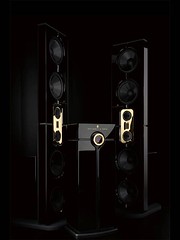 These seven-foot-high, 500-pound Steinway Lyngdorf speakers apparently sound pretty amazing. They look cool too.
These seven-foot-high, 500-pound Steinway Lyngdorf speakers apparently sound pretty amazing. They look cool too.
They'd better, for $150,000. They remind me a bit of an advertisement I saw perhaps 25 years ago in one of my mom's copies of Architectural Digest magazine. I still remember the ad copy almost perfectly:
When your neighbor asks where he can get an Aston Martin Lagonda like yours, tell him he probably can't.
(Coincidentally, back in 1976 when that particularly ugly Aston Martin model was introduced, it also cost $150,000.)
Anyway, the same Steinway magazine in which I read about the speakers featured pianos, of course, but also luxury wooden boats, high-end Swiss watches, and even (in an ad my wife spotted) custom-bred dogs.
I wonder what percentage of people who spend hundreds of thousands of dollars on a Steinway piano actually play it very often?
Labels: audio, cd, gadgets, money, music
28 February 2008
Handy handstrap
A couple of years ago I spotted Kris using a handstrap with his Canon DSLR at Northern Voice 2006. Such a strap can be quite convenient when you don't want to use a full neck strap, and in recent weeks I've thought that getting one would make my grip on my Nikon D50 a little more secure.
Alas, Nikon's own leather strap is stupidly expensive (more than $100 in Canada—you can buy a whole decent point-and-shoot camera for that!). The Canon version was much cheaper, but requires a camera with a bottom strap loop, which few have. Luckily, there was a perfectly acceptable no-name alternative at Amazon. I had to have it shipped to a friend's U.S. post box, since it wasn't available to be shipped to Canada. I received it early this week.
If you look at my camera bottom photo, you can see there's an extra strap hook on the other side of the grip mount, so you can use both the hand and a neck straps at the same time.
What that does mean is, if you use the regular neck strap that way, your camera hangs sideways, but that's fine once you get used to it. Also, the grip mount is well built plastic with key metal bits, but it's fairly large, so if you already have a big SLR, especially with a battery grip, you're heading into the massive Nikon D3/Canon 1D size territory. So check the size of your camera bag before you get one.
Labels: canon, gadgets, nikon, photography
29 January 2008
Nikon's new D60 isn't what I expected
 I was right that Nikon would introduce a new digital SLR soon, but totally wrong about where it would fit in their lineup. The new D60 is an introductory-level camera that doesn't seem to incorporate many of the revolutionary new technologies from Nikon's high end D300 and D3.
I was right that Nikon would introduce a new digital SLR soon, but totally wrong about where it would fit in their lineup. The new D60 is an introductory-level camera that doesn't seem to incorporate many of the revolutionary new technologies from Nikon's high end D300 and D3.
No-nonsense photographer Ken Rockwell thinks it's a higher-end machine than I do, with image processing that may give the D80 a run for its money. But to me, the D60 looks like it will replace the D40 and D40x—it uses the same body design, but adds some interesting new features such as a stop-motion movie mode, next-generation sensor dust removal, and a digital rangefinder for focusing lenses manually.
That last item is useful, because like the D40 and D40x, the D60 lacks an autofocus motor in the camera body, so only newer Nikon-mount lenses with the focus motor in the lens (called AF-S and AF-I by Nikon) will focus automatically. Many nice lenses, even ones Nikon still manufactures, such as the AF Nikkor 50mm f/1.8 I use—as well as numerous older lenses, both primes and zooms—can therefore only be focused manually with the D60.
Still, it is a nice camera, and a strong direct competitor to Canon's new Digital Rebel XSi announced a few days ago. Nikon's aging D80, like Canon's EOS 5D, remains in the lineup, and unless both manufacturers have further surprises up their sleeves, that's the way it looks to be for the next little while. Despite the D60's niceties, my D50 (released back in 2005) remains a better camera for my needs, primarily because it still has that autofocus motor for the three of my four lenses that lack their own.
Labels: canon, gadgets, geekery, nikon, photography
24 January 2008
More DSLR competition
UPDATE: Via John Gruber, here's an excellent introductory article on buying a digital SLR camera. I think author Mike Davidson should expand from his emphasis on Nikon and Canon alone, but all his essential advice is good regardless of brand. As you'll see in the rest of my blog post here, though, you might want to see what Nikon announces in the next couple of weeks.
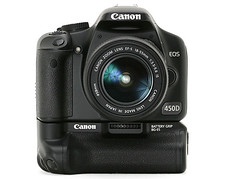 In advance of the upcoming PMA photo tradeshow, camera manufacturers have started spewing out announcements about their new products. I'm most interested in information about digital single-lens reflex (DSLR) cameras, because a Nikon D50 SLR is what I use now, and SLRs (film and digital) are what I have used for most of my photo-taking life, which stretches back almost 30 years to when I first started to figure out my dad's old film Pentax with "Asahi Pentax" viewfinder cover.
In advance of the upcoming PMA photo tradeshow, camera manufacturers have started spewing out announcements about their new products. I'm most interested in information about digital single-lens reflex (DSLR) cameras, because a Nikon D50 SLR is what I use now, and SLRs (film and digital) are what I have used for most of my photo-taking life, which stretches back almost 30 years to when I first started to figure out my dad's old film Pentax with "Asahi Pentax" viewfinder cover.
The DSLR market is especially hot right now—I was amazed at how many pre-Christmas ads were not for the regular point-and-shoot digicams most people still use, but the bulkier yet more powerful and flexible SLRs that enthusiasts prefer. It helps that the DSLRs are a whole lot cheaper than they were even a couple of years ago. Now that digital is the way everyone shoots, it makes sense that a good number of average buyers would be hitting the limits of their little cameras and wanting to take nicer pictures—not to mention that manufacturers get more money out of both the higher-priced cameras and the greater range of lenses and accessories we love to buy for them.
So far I've seen news about new intro-level DSLRs from Sony (who bought out Konica-Minolta's old camera business), Pentax (who also have a new higher-end model), Samsung (almost the same as the Pentax, since the two companies collaborated on the design), Canon, and even an almost-SLR from Fuji, which has a fixed lens but the bonus of a flip-out LCD screen and a movie mode, which true SLRs all lack. Nothing from Olympus, Panasonic, or Nikon yet, but that will come.
Since Canon and Nikon are the heavyweights in this field, Canon's new Rebel XSi (a.k.a. 450D) is the highest-profile of the bunch, though I have to say that Pentax, after languishing for some years, is really coming on strong with their recent DSLR range. The Canon XSi is a descendant of the Rebel XT (350D) my dad owns—Canon's Digital Rebel DSLRs have hugely dominated the market since they first appeared. On Flickr, for instance, it looks like there are more photgraphs taken with the XT and XTi than all other DSLRs combined. (Canon also overwhlems all other point-and-shoot makers too, by the way.)
Since Nikon (and Canon) recently introduced new high-end prosumer and multi-thousand-dollar professional SLRs, I'm wondering whether Nikon might have something less spendy to counter this new Canon model. The low-end D40 and D40x are already a success, and are not especially old either. So while I could see a new introductory Nikon, I think it's much more likely that we could see a successor to the D80, which came out in 2006, around the same time as the XSi's older sibling the XTi (400D).
Features that the D80 doesn't have, but which are becoming common in DSLRs, include dust reduction, live view (like point-and-shoots all have) on a large rear LCD screen, and of course faster-better-more in burst shooting, image quality, and maybe megapixels—although Nikon has been surprisingly smart in not letting the megapixel wars infiltrate their SLR sensors too much.
So, a D90 (or whatever) would be cool to fill in the (rather wide) gap between the D40x and the D300, and once again to fit in nicely among Canon's midrange and pro offerings, which now include the 40D and full-frame 5D—also showing its age, even if it is the current favourite among many professionals.
Labels: canon, gadgets, geekery, nikon, photography
Apple's flops
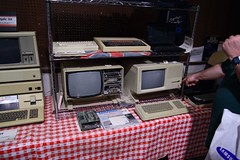 Wired has a nice list of Apple's most notorious flops, including the Newton, the Macintosh TV, and the Lisa.
Wired has a nice list of Apple's most notorious flops, including the Newton, the Macintosh TV, and the Lisa.
It's a short, decent list, but I'd argue that the Apple IIc was actually reasonably successful; why they didn't list the disastrous Apple III (or the thermal-paper SilenType printer that went with it) in its place, I don't know. Maybe the Apple III was so bad that Wired blocked it from memory.
Or PowerCD, anyone?
Labels: apple, gadgets, geekery, history
21 January 2008
Logitech's mm50 speakers may be discontinued, but they're still good
 A few days ago my wife mused that she'd like something by her bedside to listen to podcasts and music on, so she doesn't have to go to sleep wearing earphones. Gadgety guy that I am, today I went out and found her just such a thing, the Logitech mm50 iPod speaker system. While it has been superseded by Logitech's newer and very similar Pure-Fi Anywhere system, the mm50 is still widely available (for now) in the $100 to $150 range, brand new.
A few days ago my wife mused that she'd like something by her bedside to listen to podcasts and music on, so she doesn't have to go to sleep wearing earphones. Gadgety guy that I am, today I went out and found her just such a thing, the Logitech mm50 iPod speaker system. While it has been superseded by Logitech's newer and very similar Pure-Fi Anywhere system, the mm50 is still widely available (for now) in the $100 to $150 range, brand new.
I've had my eye on the mm50 since Adam Curry advertised it on his Daily Source Code podcast a couple of years ago. For our needs it's the right mix of reasonable size (it's about the length of a loaf of bread, and as deep as a thick slice), portability, ease of use, and, most of all, sound quality. The unit I bought was a discounted open-box floor demo from Best Buy, and while there I compared it to a variety of other options. It sounded superior to most of them, and better than pretty much anything in the sub-$200 category, including its newer Pure-Fi sibling.
It's not perfect. While it charges any iPod plugged into its dock connector, and includes adapters for several iPod models, the mm50 doesn't act as a true iPod dock that you can connect to your computer to sync up. (Earlier releases of the mm50 did offer that feature, and it's still noted in the manual, but newer revisions like ours don't have the necessary pass-through dock socket.) Volume control is two buttons, rather than a more sensible knob. There's no bass or treble or other equalization control—although the sound is so good those don't seem necessary, and not having them keeps down the button clutter. The included remote, while useful, doesn't offer as much iPod control as some competing models. The internal battery isn't easily replaceable.
But the mm50 supports both AC power and its internal rechargeable battery, includes a nice zippered and padded carrying case, has smart stabilizing fold-out metal feet, features a regular 1/8" stereo line input for non-iPod devices, and feels remarkably sturdy. There's a two-year warranty. The "3D surround sound" isn't really 3D, but it sounds shockingly good regardless.
I think the mm50 is a good value, especially if you can find it at a reduced price now that it's a discontinued model. My wife sure likes hers.
Labels: apple, audio, family, gadgets, ipod, logitech, podcast, shopping
17 December 2007
Shiny shiny
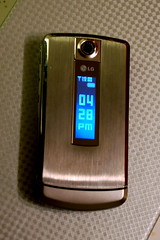 She could have waited until Christmas, but instead my wife made an early gift of it and had me pick myself a new mobile phone today. It's an LG VX8700, also known as the "Shine." Unlike my previous handset (the ancient LG 3200), it has a camera, memory expansion, outer lid screen, and Bluetooth, and it's metal.
She could have waited until Christmas, but instead my wife made an early gift of it and had me pick myself a new mobile phone today. It's an LG VX8700, also known as the "Shine." Unlike my previous handset (the ancient LG 3200), it has a camera, memory expansion, outer lid screen, and Bluetooth, and it's metal.
I know Roland "CDMA s*cks" Tanglao wouldn't agree with my choice of a non-smart CDMA phone instead of a cool Nokia-Symbian GSM device. But, quite differently than in other areas of my life, I'm not a phone geek. I have no interest in getting an iPhone, for instance. I probably wouldn't even have noticed that my old phone contract had expired if my wife hadn't pointed it out to me. I just want a phone that works, is reasonably rugged, makes and receives calls, gets decent reception, and can take a photo from time to time:
I've also stayed with Telus as my carrier for this phone, because unlike other parts of the company, their Mobility division actually seems to care about keeping loyal customers (I've been with them since 1998), and gave me a better deal on both the phone and my plan than new customers can get, plus threw in a free car charger.
Telus does cripple some of the Bluetooth functionality and other features of the phone, but I'll live with that for now. I don't want to use it as a modem, or for email or web browsing, especially at the usurious rates Canadian carriers charge for mobile data access. I've figured out how to get files to and from my MacBook via Bluetooth. I think the ringtone-purchase market is insane, but luckily there are several built-in ring options that sound like an actual telephone, so I'll use one of those.
The biggest annoyance? No way to transfer all my phone contacts over without re-entering them. Sigh. But the Shine still fits in the pocket of my carry bag (okay, okay, "man purse," as my wife calls it), which is a key consideration. Off we go.
Labels: gadgets, geekery, photography, telecommunications, telus
14 December 2007
DCRP reviews the Nikon D300 camera
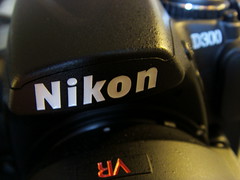 Jeff Keller's Digital Camera Resource Page has a full review of the new Nikon D300 digital SLR, posted today. I've always liked Jeff's reviews because they are both reasonably comprehensive and posted as a single long web page, which I much prefer to the multi-page versions offered at other camera review sites.
Jeff Keller's Digital Camera Resource Page has a full review of the new Nikon D300 digital SLR, posted today. I've always liked Jeff's reviews because they are both reasonably comprehensive and posted as a single long web page, which I much prefer to the multi-page versions offered at other camera review sites.
The D300 is Nikon's hefty $1800 mid-high range DSLR, aimed at somewhat spendy photo enthusiasts, as well as professionals who don't need the full-frame $5000 D3 (or who'll use it as a secondary camera for the D3). It's a huge step up from the introductory D40/40x (and the D50 before that, which I own) and mid-range D80 (or its D70/70s predecessors), and replaces the very capable D200. It competes most directly with Canon's EOS 40D and Sony's A700.
Jeff gives the D300 a rave review, nudging it ahead of the 40D (which is admittedly less expensive). The biggest differences are in low-light and high-sensitivity performance, and in the apparently amazing new high-resolution rear screen, which also offers live view (something like what you get on point-and-shoot cameras) for the first time on a Nikon SLR.
I'm still happy with my D50, since my semi-amateur photography doesn't generally push its limits, but the D300 also shows what features you can expect to see trickle down to the low end in a few years. The pace of change in digital photography is remarkable—while quality lenses will still last, the era of keeping a single main camera body for decades, as many people (including me) did in the days of film, is over.
Labels: gadgets, geekery, nikon, photography
04 December 2007
Nikons vs. Canons
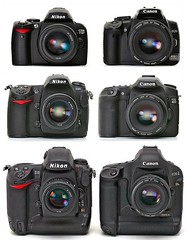 In photo-geek cirlces, Canon vs. Nikon is something like the endless Mac vs. PC debates. They are the two heavyweight gorillas of the industry, especially in the market for digital single-lens reflex (DSLR) cameras, with everyone else—Pentax, Olympus, Leica/Panasonic, Sony/Minolta, Fuji, and so on—picking up what customers they can in the giants' wake.
In photo-geek cirlces, Canon vs. Nikon is something like the endless Mac vs. PC debates. They are the two heavyweight gorillas of the industry, especially in the market for digital single-lens reflex (DSLR) cameras, with everyone else—Pentax, Olympus, Leica/Panasonic, Sony/Minolta, Fuji, and so on—picking up what customers they can in the giants' wake.
However, unlike in computerland, any decent photographer, no matter how rabid about his or her preferred brand, would likely acknowledge that both Nikon and Canon produce excellent cameras and lenses, and if given one or the other to shoot with, could do a good job with only minimal transition time. Canon has dominated in both professional and amateur circles for the past couple of decades—whereas Nikon used to be the overwhelming pro favourite in the pre-autofocus era before that.
It's interesting that Japanese companies have dominated the camera market for so long (though of course they manufacture all but their top-end cameras and lenses in places like China and Thailand). Through the first half of the twentieth century, the companies that dominated compact cameras were American (Kodak) and German (Zeiss/Contax and Leica). Kodak and Leica are still making cameras, while Japan's Kyocera bought Contax some years ago, and stopped making Contax cameras in 2005. Zeiss remains a top-end, German-based lensmaker, supplying Sony and others these days.
But while Kodak continues a respectable business in the point-and-shoot market it created more than 100 years ago ("You Press The Button and We Do The Rest" was its catchphrase then), and Leica has a strong niche market among elite buyers, and in larger formats there are companies such as Sweden's Hasselblad (now also owned by a Japanese group), Japan has been the heart of the camera industry since at least the 1960s.
I've been a Nikon guy for 25 years, ever since I graduated from my dad's old Pentax SLR to a Nikon FG I bought for myself around 1982. I could just as easily have chosen Canon or Olympus or Pentax or Minolta then, but as it was I've kept a stable of Nikon lenses about during that whole time, which meant I've kept buying Nikon bodies to go with them.
For someone new to photography, the only simple way to tell Nikon and Canon SLRs apart is by reading the name badges on their pentaprisms, and to note that Nikon likes to include a red swoosh at the top of its camera handgrips. But for people who take lots of pictures, there are differences that we've grown accustomed to.
Nikon, for example, has used the same basic lens-mount design (the F-mount) since the 1950s, so even the newest Nikon SLRs support most Nikon-mount lenses ever made, especially those from the last 30 years, as well as lots of third-party lenses, even some swanky ones from Carl Zeiss in Germany. Canon, on the other hand, has changed its lens mount a few times to support newer technologies—the last major change (to autofocus) abandoned previous Canon lens designs, but enabled faster autofocus than Nikon could achieve, which is why the pros all moved over.
That's a big difference, but the little ones are important too. How the power switch works. Which finger you use for the adjustment dials. Where the buttons are, and what the different modes are called. Some photographers (me included) prefer Nikon's approach to ergonomics, but Canon's cameras generally look sleeker, especially at the high end. Most agree that Canon's lens caps kinda suck.
But you know what? For people just getting into digital SLRs, I think the best deal right now is the Pentax K10D. It offers things that neither Canon nor Nikon does, such as weather-sealing at an introductory-level price and in-camera shake reduction that works with any Pentax-compatible lens, not just those with shake reduction built in. Unless you expect to turn pro one day, that might be a great choice.
Labels: canon, gadgets, geekery, nikon, pentax, photography
22 November 2007
The sad family of iPod Touch fonts
Apple's iPhone and iPod Touch ship with a rather limited range of web fonts, and as John Gruber wrote back in the summer:
It's a shame this wonderful display is being held back by such a poor selection of installed fonts.
I wanted to see what this meant in real-world usage, so I hopped over to Code Style's Top 40 Fonts list of most popular available type options on the Web, updated by surveys earlier this month. Here was the result when I compared the font list displayed on my MacBook (left) to the same list on the iPhone (right)—click for a full-size PNG-format version:
Notice how few fonts actually display as themselves. Of the top ten, only three (Arial, Helvetica, and Verdana) show up correctly. Courier is actually the flimsier Courier New, and everything else defaults to one variant or other of the built-in Helvetica or Arial sans-serif typefaces. Here's a close-up:
Further down the list, some of the choices (Marker Felt, Zapfino) are just bizarre to include, while others (Gill Sans, Futura, the Lucida family, my old fave Palatino) are sadly absent. I'm happy to see Georgia in there, and equally pleased that Comic Sans isn't.
Text looks great on the high-density iPod screen—it's a pity there aren't more interesting fonts to try on it. On the plus side, it's quite possible that Apple or others might be able to install some better ones through future firmware updates or software installations.
Here's hoping.
Labels: font, gadgets, geekery, iphone, ipod, macosx, typography
20 November 2007
iPod Touch: my first impressions and review
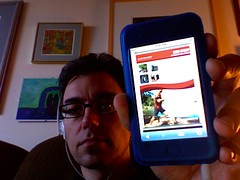 Since I'm on medical leave from work and am sitting at home feeling slightly barfy, I've had a fair bit of time to try out the iPod Touch I received yesterday. My summary: like its sibling the iPhone, it is a fantastic little portable computer. For video, enhanced podcasts with artwork, listening in the car, web browsing, and reading text, it's fabulous. However, as a pure portable music player, I think the other iPods are superior. Here's why.
Since I'm on medical leave from work and am sitting at home feeling slightly barfy, I've had a fair bit of time to try out the iPod Touch I received yesterday. My summary: like its sibling the iPhone, it is a fantastic little portable computer. For video, enhanced podcasts with artwork, listening in the car, web browsing, and reading text, it's fabulous. However, as a pure portable music player, I think the other iPods are superior. Here's why.
I miss the click wheel
The iPod Touch and iPhone lack the classic iPod click wheel, or even the round switch arrangement of the iPod Shuffle. The Touch and iPhone screens are big, beautiful, touch-sensitive blank slates—which makes them impossible to use if you can't see them. So when my iPod Touch is in my pocket, I can't skip songs, change the volume, scrub through a podcast, or even pause a track without taking it out to look at it. When I'm on the go, it's therefore slower and more awkward to use than my 5G iPod.
Yes, if you have an iPhone (not yet available in Canada), the headphones include a simple remote to address some of those problems; on the iPod Touch, you need to buy a third-party remote, which I'm seriously considering. Even then, you have only rudimentary, iPod Shuffle–like control over your player.
The click wheel is one of the great genius pieces of design in Apple's iPod lineup, a patented, distinctive component of the iPod's success since 2001. It's brave of the company to ditch it entirely on these new flagship models, in favour of the remarkable new "pinch, tap, and flick" multi-touch interface. But when you're used to the familiar thumb-spinning action of the click wheel, having to hunt for onscreen sliders and scrubbers and virtual buttons is, simply, a chore.
Good for music, great for much else, destined to get better
Don't think that I dislike the iPod Touch. When I use it, it feels like a piece of the future in my hand. I'm hugely looking forward to Apple's promised software development kit (SDK), coming in February, after which programmers everywhere will be able to create all sorts of amazing applications for it, from document readers and word processors to games and screen savers—on top of the already impressive selection of web apps out there. Right now we're limited to the programs Apple ships on it, which are interesting but few.
Because it is a more general-purpose device than other iPods, I find there's more tapping and menu navigating on the Touch, because it does more, but that makes it a little slower to use for most tasks. Some features I've become used to with other iPods, such as using my Belkin audio recorder or setting up the device as a USB flash drive, are unfortunately gone too. Like most iPods, it also feels rather fragile on its own, so I picked up a silicone case and screen protector today from Westworld, seemingly the only retailer in Vancouver with any iPod Touch accessories at all so far.
Compared to the iPhone, it has no camera, speaker/mic, physical volume switch (argh!), headphones with mini-remote, or certain built-in applications (local client email, Google Maps, etc.)—so you have to use them via the Web. The colour scheme is a bit different too. The front bezel is dark, and the back is the usual smudge-o-licious iPod chrome, rather than the flat metal of the iPhone.
It does have a YouTube app and, best of all, Apple's Safari browser. Most websites work perfectly, and the ability to zoom, rotate, and manipulate the display makes everything from using Gmail or WordPress or Blogger to reading blogs and news sites simple and surprisingly pleasant for such a small screen. The onscreen keyboard doesn't beat something real to type on, but particularly in landscape mode it works tolerably with my largish fingers. (Someone who builds an external keyboard for this thing will sell quite a few.)
I think it would make a great e-book reader, but right now there is no easy way I know of to load up text or PDF documents for reading. The Touch can display PDFs and text files from the Web very well (though I wish text files would word-wrap more neatly), but unless you want to set up your own web server (not hard for webby geeks like me) or email yourself a book (feasible but awkward), we'll have to wait for the SDK before that's easy.
Early in the revolution
The multi-touch interface is a revolution, though an early stage one. My fingers are finding themselves a bit confused. I still instinctively try the circular motion of the click wheel when wanting to adjust the volume, pause, or change tracks.
And when I get back to my MacBook laptop, I'm really flummoxed, because there I can scroll with two fingers on the trackpad too. But the scrolling direction is (quite logically, but still contradictorily) completely the opposite of the flicking motion on the Touch. On the MacBook, to scroll a page down I put two fingers on the pad and drag them down; on the Touch, I use one finger on the screen and flick the page up. The transition is like switching between two languages you're fluent in—it takes a bit of time for your brain to make the change.
The cool factor of the iPod Touch is certainly hard to beat. The screen is super-sharp, and photos and video look just great on it. The Touch also works perfectly with my car FM adapter, and in that context it's better than the old iPod because you can see the screen better—but I had to turn the brightness down when I tried it last night, because it was like a searchlight compared to the dashboard instruments!
A device unsure of itself
When the iPhone first came out, many people wanted one without the phone part. The iPod Touch is pretty close, but that also makes it a device that isn't quite sure what it wants to be. Is it a portable computer? A music player? A video device? A web appliance? Well, yes and not quite. Apple positions it and the iPhone as their top-of-the-line models, but if you listen to a lot of audio, or need to record, or like to store data too, think carefully. The massive storage and reliable old click wheel of the iPod Classic or the miniscule convenience of the iPod Nano might work better for you.
Despite that, I suspect that I'll be carrying and listening to the iPod Touch a lot more than my old 5G iPod. When I wake the screen from sleep and slide the virtual switch to unlock it, or flip the iPod sideways and watch the screen display flip too, or grab a chunk of web page and move my fingers to zoom it, or flick a list of podcasts and observe the carefully-calibrated ballistics of how the list decelerates to a stop, there's something amazing about that experience. It's a new kind of computer in my pocket.
A few niggles here and there don't negate the amazement. And I get the feeling that once it's no longer amazing, that experience will simply be something I expect, and almost everything else will seem old-fashioned.
Labels: apple, design, gadgets, geekery, ipod, macosx, music, video
19 November 2007
Warming the cockles of geeks' hearts
UPDATE: See my review of the iPod Touch.
 The company I work for, Navarik, has been amazingly supportive during my medical leave for cancer treatment. It has always been a great place to work, even in the darkest depths of the dot-com bust in which the company started in 2000 (I did freelance editing work for them back then, and started as a proper employee in 2003). That's because the company's founders—university colleagues of mine—created a culture where people are important. It's the main reason I wanted to work there originally, because in the technology industry, you can't necessarily predict what kind of work you'll be doing in the future—but you can judge the culture of your employer pretty easily.
The company I work for, Navarik, has been amazingly supportive during my medical leave for cancer treatment. It has always been a great place to work, even in the darkest depths of the dot-com bust in which the company started in 2000 (I did freelance editing work for them back then, and started as a proper employee in 2003). That's because the company's founders—university colleagues of mine—created a culture where people are important. It's the main reason I wanted to work there originally, because in the technology industry, you can't necessarily predict what kind of work you'll be doing in the future—but you can judge the culture of your employer pretty easily.
While I've been here at home recovering from surgery and pumping my body full of chemotherapy poisons, everyone else at Navarik has been working incredibly hard on some fascinating and powerful software that will help many people in the maritime shipping industry and elsewhere around the world do their jobs better.
This afternoon my daughters and I dropped by the office for the first time in some months. Coincidentally, it was the same day that the management team presented each employee with a Navarik-personalized iPod Touch (what's the plural of that? iPod Touches? iPods Touch?) as thanks for that effort. Amazingly, I received one too. The accompanying handwritten note from our CEO brought me (and my wife, when she read it) pretty close to tears.
This is not a new thing, nor a token attempt at recognizing the great people who work for the company. I'll write about my impressions of the iPod Touch tomorrow, but my impression of Navarik has only been reinforced: it would be hard to find a better place to work.
Labels: apple, cancer, friends, gadgets, ipod, navarik
05 September 2007
That's some serious iPodage
 It's remarkable how Apple simply announces new products and instantly makes its previous generation seem obsolete. Check out today's new iPods, for instance.
It's remarkable how Apple simply announces new products and instantly makes its previous generation seem obsolete. Check out today's new iPods, for instance.
The iPod touch is the obvious standout, essentially a marginally shorter iPhone, without the phone or camera. But the newly christened "iPod classic," which succeeds the fifth generation video iPod I own, which has been around for almost two years, now has an all-metal case and comes in 80 GB (large) and 160 GB (insanely large) capacities.
The iPod nano (disbelievingly nicknamed the "iPod fatty" by those who saw mockups before today) is like its predecessor chopped in half, with a new interface and colours. Only the iPod shuffle hasn't changed too much, with new colours including the AIDS-benefit red.
The iPod classic is the sweet spot if you have a lot of music and don't want the huge touchscreen and Wi-Fi of the iPod touch. I'll be interested to see how they sell—the iPod touch is way cooler, of course, but only stores 10% of the stuff.
For lots of people it will be an expensive Christmas, from the looks of it.
Labels: apple, gadgets, geekery, ipod
10 June 2007
Avoiding free-advice leeches
Here's some decent advice about how to avoid being pestered for free advice about something you're an expert in (via Brian Chin). Some complaints:
Las Vegas poker champion Scott Fischman [...] says that when he's invited to social gatherings, he has to decide: "Do I want to spend four hours answering questions or should I just stay home?"
Lisa Jacobson is founder of Inspirica, a New York tutoring and test-preparation firm. [She] even suspects that some parents of grade-schoolers have befriended her because they hope she'll be an asset when their kids are college-bound.
At a cocktail party, if someone says to a doctor, "I have a medical question," the doctor can always deliver the old line: "Great. Just get undressed." Now, those in newer professions—especially computing—are amassing their own quips.
I don't get hit with this sort of stuff too often, and usually the people who ask me for free advice (most often about computer stuff) are those I've invited to—family and friends whom I've helped when they bought a computer, and so on. But it might be good to keep some one-liners in your back pocket if you're a likely target.
Labels: family, friends, gadgets, geekery
08 June 2007
How to clean your SLR sensor
 One problem with digital SLR cameras (DSLRs) is that, because their lenses are interchangeable, and unlike "sealed" point and shoot cameras that most people have, they're prone to accumulating dust on their sensors, which can create spots on the images they take. I actually had to return my first DSLR because it came with such spots, rather than developing them slowly over time as is more normal.
One problem with digital SLR cameras (DSLRs) is that, because their lenses are interchangeable, and unlike "sealed" point and shoot cameras that most people have, they're prone to accumulating dust on their sensors, which can create spots on the images they take. I actually had to return my first DSLR because it came with such spots, rather than developing them slowly over time as is more normal.
In the old days of film, dust wasn't as much of a problem because every time you changed film, you changed the sensor surface. That's also why film cameras could remain useful for decades—you can use modern, higher-tech film in a 50-year-old camera with good results. With digital photography, to upgrade the sensor surface you have to replace the whole camera. That's one reason extremely expensive digital cameras like the Leica M8 are more fetish items than wise purchases.
Anyway, Macworld has a useful article on some tools to help clean dust from DSLR sensors. That includes magnifying loupes, cleaning solutions and brushes, and so on. It's an iffy process that could void your warranty, so it might be wiser to have a dealer do it rather than trying it yourself. I don't need to yet, so we'll see what I decide when that time comes.
Labels: gadgets, geekery, nikon, photography, repairs
23 May 2007
Lens like a jewel
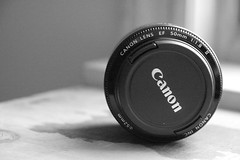 Yesterday was not only my last day of radiation and the day I found out that, "Dude! I'm gettin' a colostomy!" It was also my father's 68th birthday—we're mere weeks from being exactly 30 years apart in age.
Yesterday was not only my last day of radiation and the day I found out that, "Dude! I'm gettin' a colostomy!" It was also my father's 68th birthday—we're mere weeks from being exactly 30 years apart in age.
My wife and daughters and I dropped by my parents' place for the occasion last night and had some cake with them. My girls handmade cards, plus some extremely cool presents: little plasticene models of my dad, one on his own (from my seven year old) and one with his telescope (from my nine year old).
I wasn't that creative, but unlike last week, when I was totally out of it for Mother's Day, I did manage to buy him something: a nice basic 50 mm prime lens for his Canon DSLR camera. If you have a DSLR and don't have at least one prime lens (with a single focal length like 24 mm or 50 mm or 105 mm, which does not zoom), get one. They are much nicer for the money and let in more light than equivalently priced zooms. In fact, I wish DSLRs came with 50 mm lenses like film SLRs used to for decades.
For those of you who aren't photo geeks, understand this: when he opened the wrapping, he was just as delighted as a woman opening a surprise gift of jewelry. Yup, we guys really do like our gadgets that much.
Labels: birthday, family, gadgets, geekery, photography
